Texas is the second largest state in the U.S., and with such a diverse landscape it’s the perfect place for a wide range of animals to live. There are approximately 100 different species of snakes in Texas, but you might be surprised to find that they are not all native to the state. That’s right, owing largely to the pet trade, there are five invasive snakes in Texas and these huge animals pose a series threat to native wildlife. Let’s find out which they are!
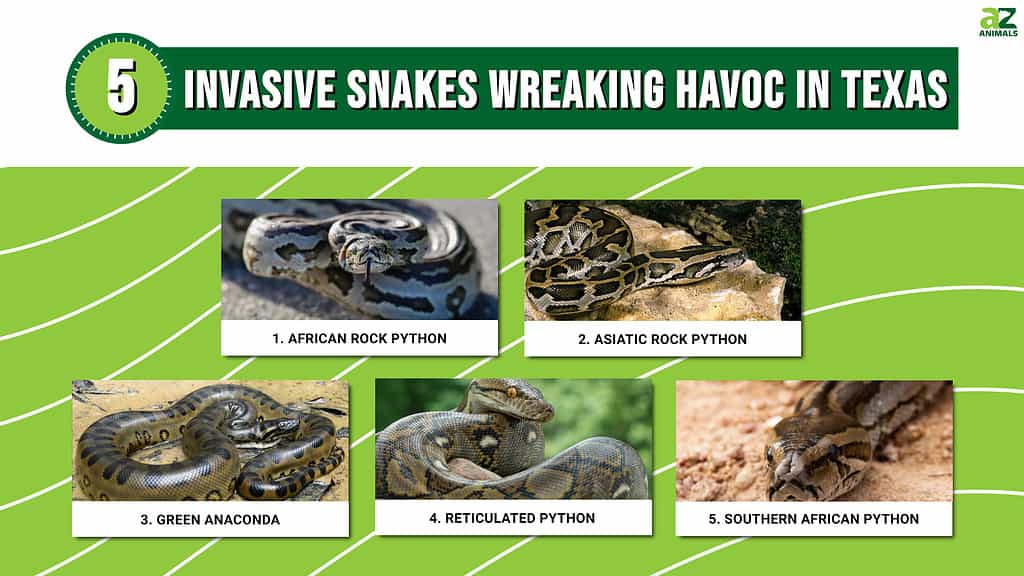
1. African Rock Python (Python sebae)
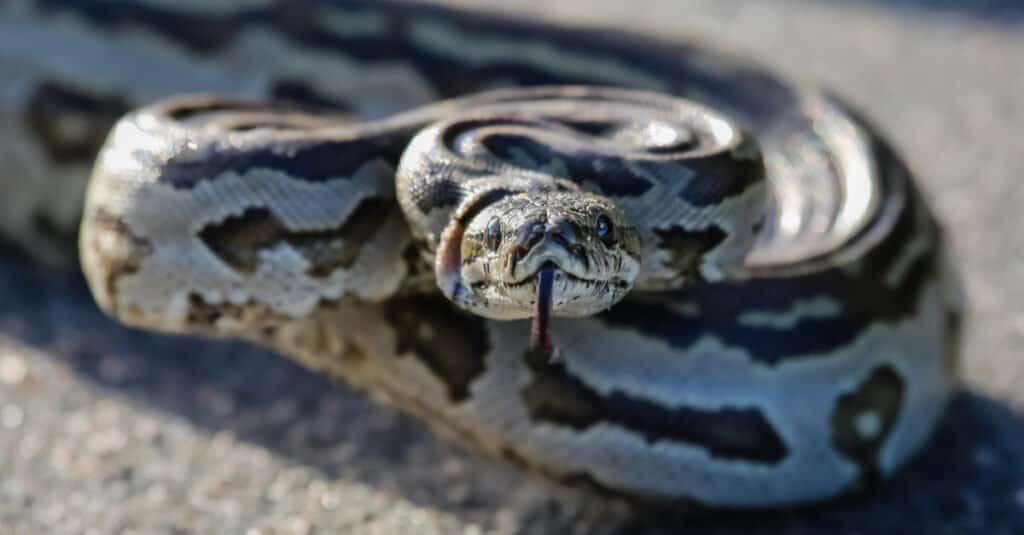
Native to sub-Saharan
Africa
, African rock pythons are an invasive species in the United States.
©Uwe Bergwitz/Shutterstock.com
There are four invasive pythons in Texas and the first is the African rock python. African rock pythons are huge animals that typically reach between 10 and 16 feet long. However, specimens as long as 20 feet have been observed. They are powerful snakes with heavy, brown bodies. They also have dark-colored blotches along either side of their body that are bordered with black. African rock pythons also have a triangular-shaped head with a distinctive stripe on each side which joins on the top of their nose to form a “spear-head” marking.
African rock pythons are native to sub-Saharan Africa, where they inhabit a variety of habitats — including forests, grasslands, deserts, and rocky regions. They are not native to the U.S. and were introduced to the country through the pet trade. Escaped or released pets are able to quickly establish themselves in the area so long as there is sufficient food. Due to their large size, African rock pythons will eat whatever they can catch. They also have very few predators other than alligators. As a result, these invasive snakes quickly harm the native wildlife population and they can even begin to threaten rare and endangered species.
2. Asiatic Rock Python (Python molurus)
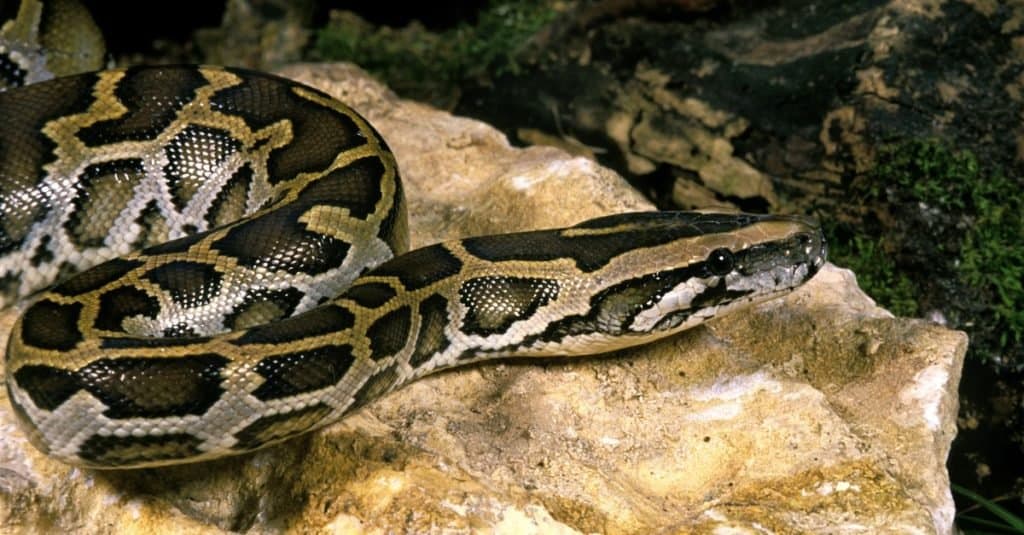
Asiatic rock pythons are also called Indian pythons and are powerful snakes.
©slowmotiongli/Shutterstock.com
Also known as the Indian python, the Asiatic rock python is another powerful snake, although smaller than the African rock python at approximately 10 feet long. Asiatic rock pythons have a yellowish ground color which is overlaid with tan to dark brown blotches. They are native to India and prefer shaded wetland habitats such as swamps and river valleys.
Like the African rock python, the Asiatic rock python was introduced to the country through the exotic pet trade and concerns have grown for Texas’ native wildlife due to its presence in the state. Asiatic rock pythons are constrictors and typically prey on mammals of various sizes. Although they kill their prey by constriction they also have sharp, backward-pointing teeth, which they can use to further prevent prey from escaping.
3. Green Anaconda (Eunectes murinus)
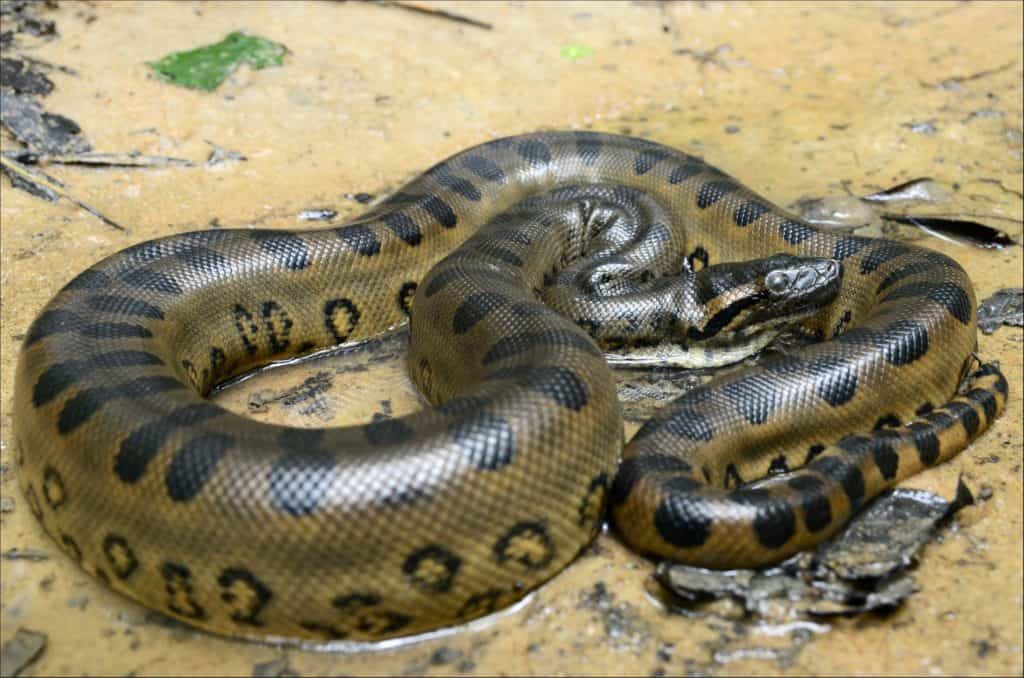
Green anacondas are one of the largest and heaviest snakes in the world.
©Patrick K. Campbell/Shutterstock.com
Famous for being one of the longest and heaviest snakes in the world, the green anaconda is definitely a snake that you want to avoid. These massive snakes can reach 30 feet long (although the average is 17 feet) and weigh up to 550 pounds. They have an olive green background color which is overlaid with black blotches. They also have some smaller spots with yellow centers along their sides. Green anacondas typically live in habitats close to water. They are also excellent swimmers. In fact, they are perfectly adapted to a semi-aquatic lifestyle, owing to the position of their eyes and nostrils on the top of their head. This allows them to remain almost completely submerged in the water while watching and waiting for the perfect moment to strike at their prey.
Green anacondas are apex predators. They prey on anything that they can overpower — whether birds, mammals, fish, amphibians, or other reptiles. Animals as large as deer are fairly common prey for larger anacondas. Although it is not known how many anacondas there are in Texas, the predatory nature of this snake and its position as a top predator put native wildlife under serious threat.
4. Reticulated Python (Malayopython reticulatus)
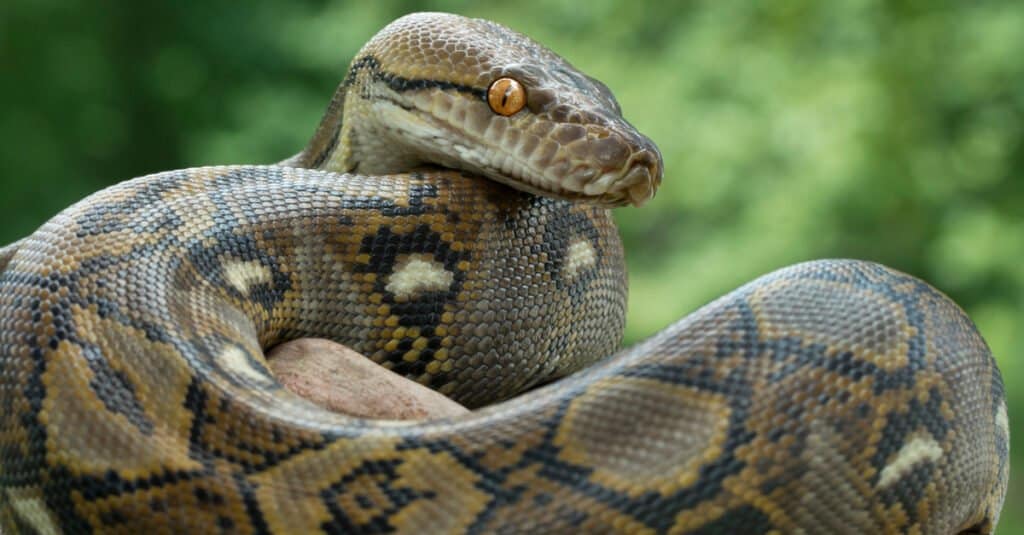
While legal to own as a pet in Texas with the right permit, escaped reticulated pythons have made them an invasive species there.
©Mark_Kostich/Shutterstock.com
Although it is legal to own a reticulated python in Texas with the correct permit, escaped pets can wreak havoc on the local wildlife. This is because they are one of the longest snakes in the world at 20 to 30 feet. Reticulated pythons have a tan to brown ground color. This is overlaid with an irregular series of diamond-shaped markings which create a “net-like” pattern. These markings are typically bordered with black.
Reticulated pythons are native to south and southeast Asia. Like the other snakes on the list, they came to Texas as a result of the pet trade. They typically inhabit woodlands, forests, and grasslands. However, they also often live near streams and rivers and are accomplished swimmers. Reticulated pythons are ambush predators and kill by constriction. They predominantly eat mammals and are one of the few pythons where there are several documented cases of them killing and eating humans.
5. Southern African Python (Python natalensis)
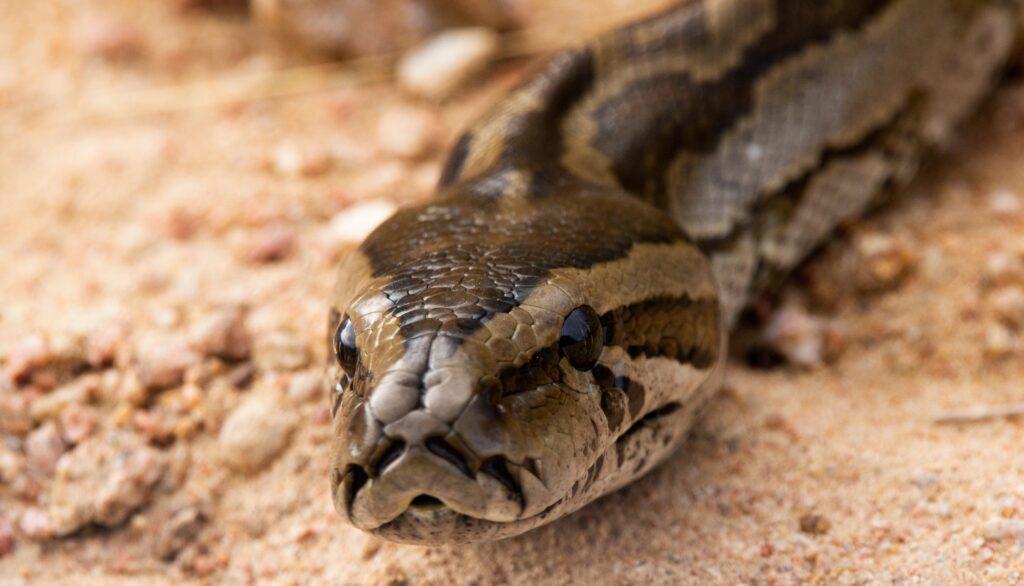
Female Southern African pythons are longer and heavier than their male counterparts.
©Bruce Crossey/Shutterstock.com
The final invasive snake in Texas is the Southern African python which typically reaches nine to 13 feet long. They exhibit sexual dimorphism and the females are both longer and heavier than the males. Southern African pythons are dark brown with greyish-brown blotches. They also have an arrow-shaped mark on their heads as well as dark lines, which extend from their eyes to the widest part of their head.
Southern African pythons typically live in lowland forests and on rocky outcrops. However, they can also be found near water too. They are nocturnal snakes but can often be seen basking out on rocks in the sun. They are oviparous snakes and the females lay between 30 and 50 eggs. The nesting site can include abandoned termite nests or mammal burrows. The female does not eat during the incubation period, but will sometimes leave the eggs to drink water. Once again, they are ambush predators and eat a variety of mammals, birds, reptiles, and fish.
Summary of 5 Invasive Snakes Wreaking Havoc in Texas
Here’s a recap of the 5 invasive snakes in the state of Texas we took a close look at:
| Number | Snake | Scientific Name |
|---|---|---|
| 1 | African Rock Python | Python sebae |
| 2 | Asiatic Rock Python | Python molurus |
| 3 | Green Anaconda | Eunectes murinu |
| 4 | Reticulated Python | Malayopython reticulatus |
| 5 | Southern African Python | Python natalensis |
The photo featured at the top of this post is © Mark_Kostich/Shutterstock.com
Discover the "Monster" Snake 5X Bigger than an Anaconda
Every day A-Z Animals sends out some of the most incredible facts in the world from our free newsletter. Want to discover the 10 most beautiful snakes in the world, a "snake island" where you're never more than 3 feet from danger, or a "monster" snake 5X larger than an anaconda? Then sign up right now and you'll start receiving our daily newsletter absolutely free.
Thank you for reading! Have some feedback for us? Contact the AZ Animals editorial team.






